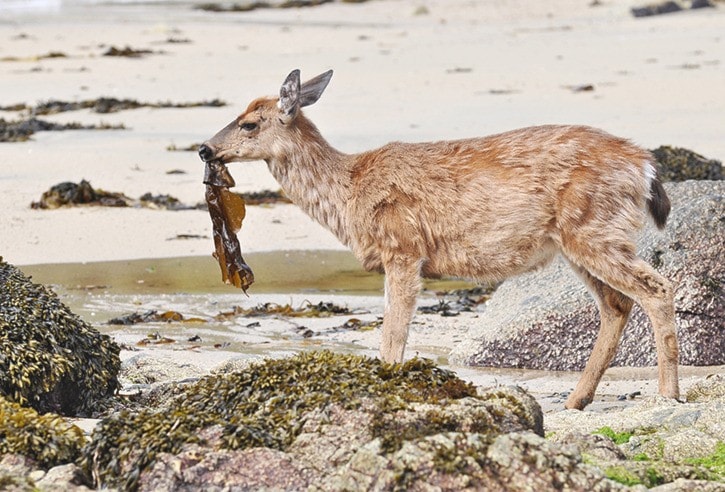Even with his eyes closed, Judson Brown can tell Lost Island is one of the few Gwaii Haanas islands without deer.
The little island buzzes with insects and rings with shrub-nesting songbirds.
“We were just in awe,” says Brown, a Gwaii Haanas warden who is used to working on islands that are too quiet — islands where deer have stripped away most plants, shrubs, and seedling trees.
Starting next spring, Brown will join a Gwaii Haanas project to rid all the deer from six islands south of Lyell Island and get their ecosystems humming again.
Called Restoring the Balance, or Llgaay gwii sdihlda, the project is not a cull, but a full eradication — expert marksmen will be tasked with killing every last deer on Ramsay Island and five others nearby.
Separately approved by the SPCA, the plan is to donate some deer killed in the earliest stage of the March to July project to local Meals on Wheels and school lunch programs.
Haida Gwaii hunters may also be invited to help reduce deer numbers along the southern part of Lyell, to discourage deer from swimming south and re-invading the Bischof, House, Hotspring, Ramsay, Murchison or Faraday Islands.
Brown, his colleague Robyn Irvine, and Barb Wilson, a researcher and former cultural resource manager for Gwaii Haanas, spoke about the project as part of an Aug. 10 talk on restoring ecosystems at the Kay Centre.
If it works, Brown said one big hope is that the larger, stream-bearing Ramsay Island will once again grow a full range of native Haida Gwaii plants and “will become our medicine cabinet.”
Barb Wilson agrees.
“I really want you to embrace the thought of the plants and the medicines that can come from this,” she said.
“We don’t know what kind of things we could be missing.”

Getting the islands’ ecosystems humming again has many other benefits — restoring all the understory plants that the deer are eating is just a start.
From leaf-eating weevils up to songbirds and the threatened Northern Goshawk, the project could bring a greater diversity of animal species.
Robyn Irvine showed a photo from one island where small areas were fenced off from deer in the 1990s to see how the understory would regrow.
Each area was only 40 square feet, but even that was large enough for some otherwise absent songbird species to return.
Along with the Haida Nation plan for Gwaii Haanas — which includes the goal of growing monumental cedar for the next 1,000 years — Irvine said Restoring the Balance is inspired by the work of scientists such as Jean-Louis Martin.
Martin studies the impact of introduced species and other human changes on temperate ecosystems, and recently gave his own Kay Centre talk on his many years of work in Gwaii Haanas.
For Irvine, the most surprising finding is that so long as invasive deer remain on an island, the losses don’t stop.
“If you keep deer on the islands, you think at some point, ‘Well, all that we’re going to lose has been lost,’” she said.
“But that doesn’t happen. They continue to see loss of songbirds, they continue to see loss of insects, and they continue to see changes in the soil structure and diversity of plants for every year the deer are there.”
Asked how many deer are present on Haida Gwaii, Irvine said a precise estimate is hard to come by.
In 1998, when Wilson published a paper on the issue, an accepted estimate was about 60,000.
Brown said he expects it has fallen since then, as logging has decreased on the islands and deer have fewer open cutblocks to feed in.
They can often be seen eating kelp off the beach or rearing back to eat higher than the browse line—signs they are eating themselves out of food.
Whatever the number, it’s clear that since the B.C. Game Commission introduced a few dozen deer to the islands between 1880 and 1925, the population has exploded and spread to nearly every part of Haida Gwaii thanks to a lack of winter, wolves, and any other predators aside from people.
As for questions about cost, Irvine said a rule of thumb in deer eradication is that 90 per cent of the money is spent on the last 10 per cent of deer.
“It’s only successful if every deer is gone,” she said.
While Irvine admitted that the six islands are only a small part of Gwaii Haanas, let alone Haida Gwaii, larger island restorations like the one ridding South Georgia of rats and mice give some hope for even more ambitious plans in the future.
“That kind of scale is starting to come into the realm of possibility, but it requires huge partnerships, international funding, and focus.”

